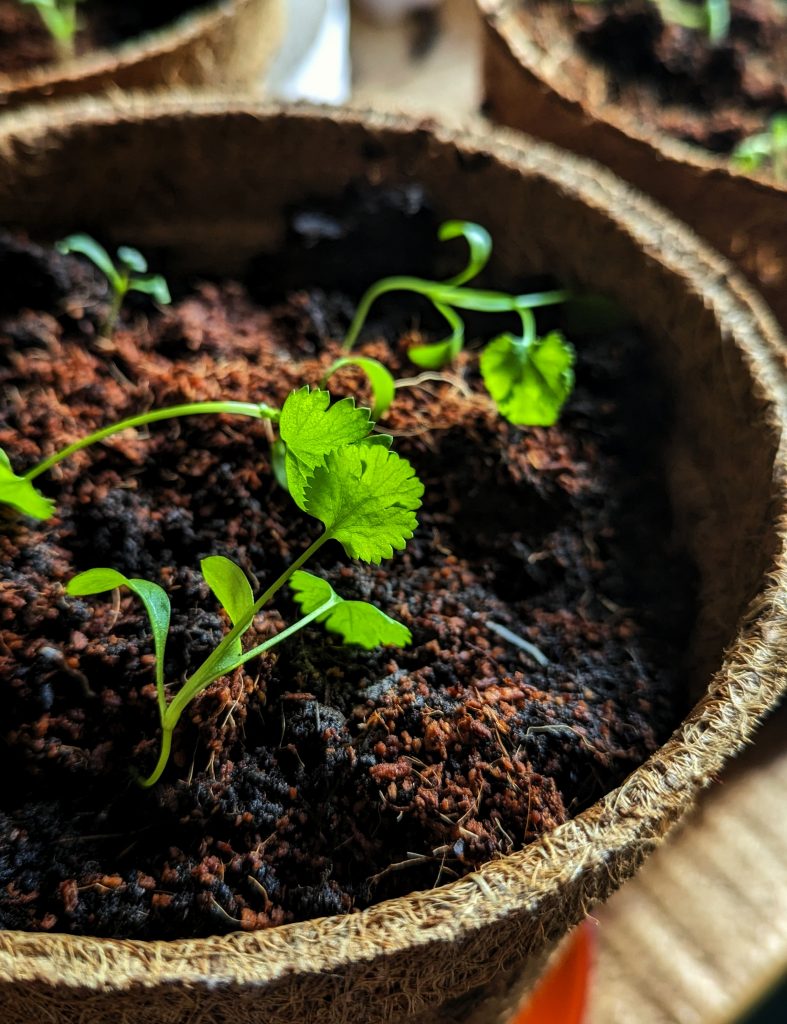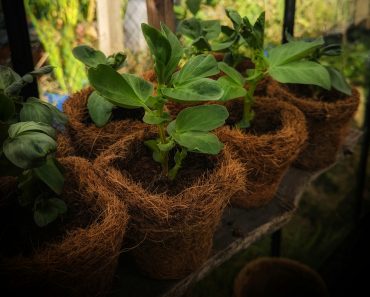Coriander, also known as Cilantro has become a very popular Annual herb to grow at home. The fragrant Leaves can be added to salads and the spicy seeds can be a wonderful addition to Tai, Chinese and Indian Curry’s. Coriander is packed with a vast array of health benefits too! Read on to find out how to grow, harvest and use this wonderfully spicy plant!..

Coriander Origins
Coriander, (Coriandrum sativum) is a feathery annual herb and a member of the parsley family (Apiaceae), all parts of the plant are edible, but it is mostly the leaves and the dried seeds that are traditionally used in Cooking
Coriander is an Ancient Herb with a rich history! It is Believed that Coriander was first sown as a spice crop in the Anatolian region of present-day Turkey. From there it spread to Egypt, where it was primarily used as a medicinal herb.
So old is this plant that there is an Egyptian papyrus dating from 2500 to 1550 BCE ! which describes the use of the herb by Ancient Egyption Physicians.

A Royal Favourite!
So highly regarded was this herb that the remains of several baskets of Coriander seeds were found inside the tomb of the Egyptian King Tut-ankh-Amon.
The ancient Egyptians believed that when they died their spiritual body would awaken and continue to exist in an afterlife similar to their living world. But..entry into this new life was not guaranteed!
Tombs would be filled with objects of value and benefit in order to negotiate their admittance. Coriander would have been a helpful bargaining chip due to its usefulness as an antidote for snake bites and it’s common use in wines and food
Coriander Characteristics
- Coriander is an erect annual herb that can reach heights of between 30 cm to 120 cm dependant on the conditions of where it is grown.
- The leaves differ in shape depending on age- Young Coriander leaves are rounded and slightly stilted while older leaves are broadly lobed at the base of the plant, and slender and feathery higher up the flowering stems.
- The stems form numerous side shoots giving the plant a full, branched out appearance
- Coriander flowers appear between late May and August. They are white or cream in colour with 5 petals and contain 3-5 pink flower stigmas (they are quite beautiful!)
- After flowering spherical light brown fruits are produced which are around 4 mm in diameter. Within these pods are the seeds which are a yellowy colour and have a citrus like scent similar to the leaves
8 Surprising Health Benefits Of Coriander
1: Supports Eye Health
Coriander leaves are rich in Vitamin A, Vitamin C, Vitamin E and carotenoids, which are all helpful in promoting good vision and eye health.
2: Improves Immunity
Coriander contains several antioxidants and antioxidants have been shown to fight inflammation in your body. Coriander can help to prevent cellular damage caused by free radicals helping you to build a stronger and healthier immune system
3: Helpful With Managing Blood Sugar Levels
There are ongoing studies that suggest coriander seeds have the ability to reduce blood sugar by promoting enzyme activity that helps remove sugar from the blood. In fact, it works so well that people who take diabetes medication should monitor their Coriander intake closely- due to its effectiveness in that area
4: Supports Heart Health
Regular consumption of coriander leaves may help reduce LDL (bad) cholesterol and improve HDL (good) cholesterol. Coriander can also act as a diuretic, helping your body flush away excess sodium and water- which in turn may help to lower your blood pressure.
There is even undeniable evidence that populations who consume large amounts of coriander, tend to have lower instances of heart disease, especially when compared to people on a western diet of high sugar and high salt food.
5: Great For Bone Health
Coriander leaves are full of minerals like calcium, manganese, magnesium and phosphorus all wonderful for Bone Health! The main one, Calcium as we all know, plays an essential part in bone regrowth and the prevention of the disease osteoporosis.
6: Helpful with Gut Health
Coriander leaves are rich in fibre, which is helpful in managing digestive issues. It can also reduce unpleasant digestive symptoms like bloating.
7: Promotes Skin Health
Full Of Iron, Vitamin A and Vitamin E, it is a helpful ally in the fight against free radicals that can damage the skin. Coriander also has antimicrobial, antiseptic and antifungal applications that can help soothe and cool the skin.
8: Promotes Brain Health
Corianders’ anti-inflammatory properties are helpful when realising that most degenerative Brain diseases are triggered by inflammation. Studies have found that Coriander extract had the ability to protect brain cells from damage and even improve memory! It was also found that Coriander Extract could be helpful in lowering anxiety levels!
How To Grow Coriander From Seed
Affiliate Links
Sow Indoors– February To April
- Sow Seeds in Modules or Pots around 1/4 inch deep in damp compost
- Place on a Sunny Windowsill and Cover with a propagator lid or cling wrap until seedlings emerge
- Plant out once all risk of frost has passed, be sure to harden off indoor raised plants first *Coriander do not like their roots disturbed, so transplant the whole module or pot gently to its final spot.

What Does Hardening Off Mean?
Plants raised indoors or in a greenhouse environment, need to be acclimatised to cooler temperatures and increased air movement for about two to three weeks before they are planted outdoors permanently. This is a ‘toughening up’ practice to prepare the plants for their new environment.
How to Harden Off
Place your plants out for a couple of hours in a shady part of the garden. The next day, leave them out again for two hours, but this time allow the plants an hour of direct sunshine in the morning. Gradually continue to increase the length of time the plants are in direct sunshine over the course of roughly two weeks.
Sow Outdoors- May to July
- Sow Coriander Seeds in a prepared bed in free draining soil
- Sow in drills at roughly 10 cm apart and 1/4 inch deep
- Water them in and watch them grow!
Where To Plant Coriander
Plant in a sunny or part shaded spot in a free-draining soil. Coriander also grows particularly well in pots, due to its preference for free-draining conditions.

Coriander Water Requirements
Coriander really loves a good drink! Water, but don’t overwater- feel the soil before watering if it feels damp its fine
Companion Planting With Coriander
Good Coriander Companion Plants
- Dill
- Chervil
- Basil
- Parsley
- Carrots
- Spinach
- Cabbage
- Cauliflower
- Kale
- Kohlrabi
- Green Beans
- Lettuce
- Legumes
- Potatoes
- Tomatoes
Bad Coriander Companion Plants
- Lavender
- Thyme
- Rosemary
- Fennel
When To Harvest Coriander
Coriander leaves, flowers, stems and seeds are all completely edible and can be harvested from around mid-summer onwards
Want To Grow A Herb Garden?
- How To Grow Chives
- How To Grow Applemint
- How To Grow Sage
- How To Grow Lemon Balm
- How To Grow Stevia-200 times sweeter than Sugar!
- How To Grow Rosemary
- How To Grow Spearmint
Want To Grow A Vegetable Garden?
- Lemon Cucumbers
- How to grow Giant Mustard
- How to grow Perfect Carrots
- How To Grow Beetroot
- How To Grow Garlic
- How To Grow SweetCorn
- How To Grow Broccoli in Pots
- How To Grow Spring onions
- How To Grow Analena Lettuce
Looking For more ‘Homely’ Inspo ?
Have a Nosey Around the Blog! See what i’ve been Baking, Growing and Brewing! Also, pop over and say Hi on Instagram
*Any specific health claim or nutritional claims or information provided on the Website are for informational purposes only. Nothing on the Website is offered or intended to be a substitute for professional medical, health, or nutritional advice, diagnosis, or treatment. This Website is not intended to diagnose, treat, cure or prevent any disease. You assume full responsibility for consulting a qualified health professional regarding health conditions or concerns.







